Train Track
Update: The future is 3D
printing
8
February 2014
Over the last year many iterations of track have been tested.
In
October 2013 an entire loop of track was shown at BrickCon in Seattle
Washington (see below) and ran very well (using a stock 9v train
controller).
Moving forward Big Ben Bricks has no plans to develop tooling and
injection mold train track for LEGO trains. Instead, the
future for train track is with 3D
printing. 3D
printing is a way to 'print' your own plastic
parts based on a digital 3D design. 3D
printing technology
is quickly becoming very accessible in terms of cost and ease of use.
Further, the quality of print is quickly improving and the
cost
of the plastic is dropping as well - currently about $1 in plastic to
print one piece of track.
Only with 3D printing will it be possible to create the wide range of
pieces LEGO train builders want at reasonable prices.
With this strategy in mind, two types of track have been tested.
Metal rail with plastic ties and all plastic track. Please
see below for more information.
(click on images for larger, hi-resolution views)
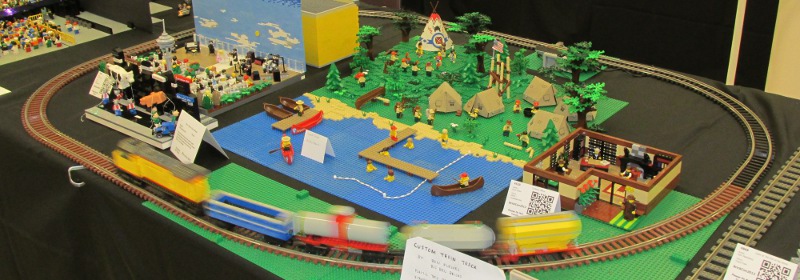
Sample oval of metal track at BrickCon in Seattle, Washington -
October 2013.
Metal rail with plastic
ties
For metal rail, code 250 Nickel-Silver rail and rail joiners are bonded
to plastic sections of ties printed on a 3D printer. This
provides an excellent running surface, excellent
conductivity of the rail, good corrosion resistance and excellent
conductivity between sections of rail.
To achieve the layout shown above sections of track were made in three
lengths
of straights and three different curves.

72 stud radius curve
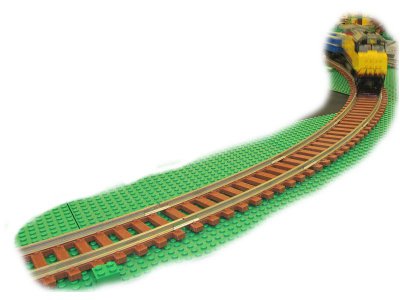
104 stud radius curve

3 straights (8 studs, 16 studs and 32 studs)
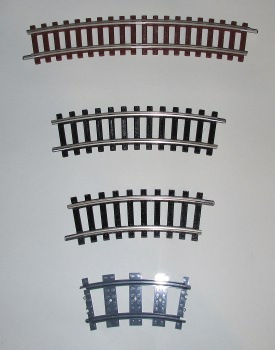
3 curves (104 stud radius -11.25 degrees (two shown, connected
together), 72 stud
radius-22.5 degrees and 56 stud radius-22.5 degrees)
(Standard
LEGO curve shown for comparison)
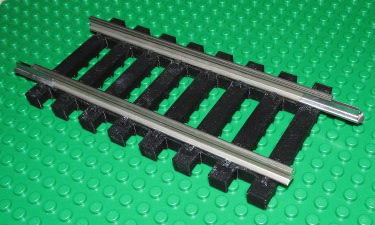
Close up detail of straight track
The metal rail on the curves is pre-formed with a simple rail bending
jig and cut to length. The plastic ties are the shaped as two 1x8
plates stacked on top of one another. The ties are offset from
the standard grid to allow full symmetry of the part. The code
250 rail is nearly identical in size to standard LEGO rail. The
precision of the 3D print is sufficient to allow a full 32 stud long
straight section to provide adequate 'clutch' power on LEGO baseplates.
All plastic track
For those preferring battery powered trains, all plastic track
is
achievable too.
Sample pieces were printed in a metallic gray plastic.
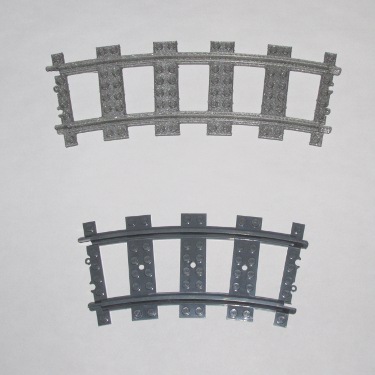
Top: 56 stud radius, 22.5 degree curve - 3D printed track
Bottom: Standard LEGO curve for comparison

Close up of all plastic curve.
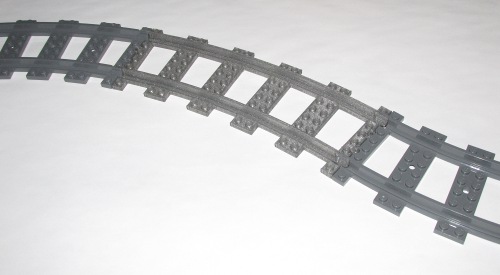
3D printed curve connected to two standard LEGO curves.
All plastic track printed well and provided a rolling surface
comparable to standard, LEGO track. The very fine detail in
the track joints is a challenge for 3D Printing, but in testing, while
the joint was found to be a bit stiff, was still acceptable. The
stiffness is mostly the result of using PLA plastic which is more
rigid then ABS plastic. 3D printing is ABS is possible, but PLA
is a bit easier to work with.
Questions and Answers:
Question: Will Big Ben Bricks
sell 3D printed track?
Answer: No. While the
technology is advancing quickly, 3D
printing is rather labor intensive. Others may be
interested in printing track with their own 3D printers.
Question: Will Big Ben
Bricks make 3D designs suitable for 3D
printing available for others to use?
Answer: Provided there is
enough interest, 3D designs will be
provided for a nominal fee. For those that would like a
sample 3D
model, please email with a
request.
Question: What 3D Printer did you use?
Answer: All track shown here
are printed with PLA plastic using a MakerGear M2 printer. Fully
assembled printers can be purchased for less then $2000.
Question: Is 3D printing easy and trouble free?
Answer: It is getting easier
and more trouble free every year, but currently a little tinkering is
typically required to make everything work just right.


